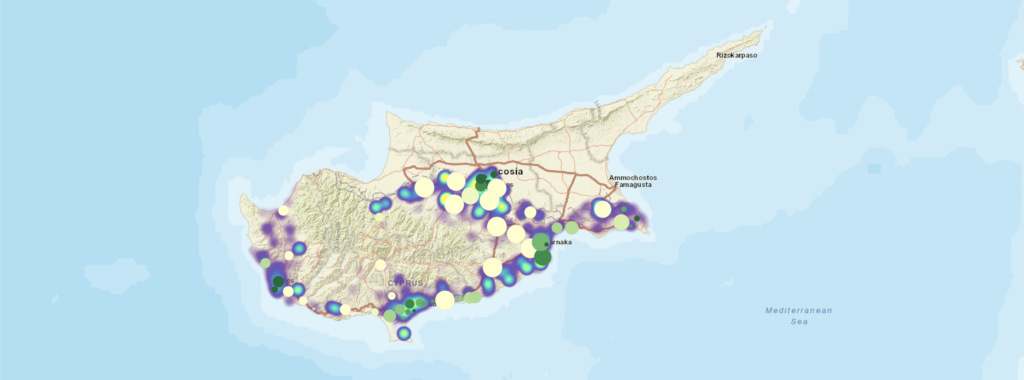Cyprus has no shortage of investor appetite for solar power, but the country’s energy system is buckling under its own limitations. According to Phanos Karantonis, president of the Cyprus Association of Renewable Energy Companies (SEAPEK), the real bottleneck is not demand but the electricity grid itself.
In an interview with Economy Today, Karantonis warned that without urgent upgrades to infrastructure and investment in storage, the future of Cyprus solar energy will remain uncertain. “There is no saturation of interest. There is saturation of the system,” he said.
Licensed but unbuilt
Cyprus has hundreds of licensed photovoltaic projects that may never be realised. According to the Cyprus Energy Regulatory Authority (RAEK), there are currently 177 applications for commercial solar parks under review, totalling 240 MW. On top of that, thousands of megawatts of licensed projects remain inactive, stuck in planning or awaiting other permits.
SEAPEK estimates that more than 2,500 MW of licensed but unbuilt projects exist today. In practice, many of these may never be completed because of planning restrictions, lack of financing, or simply because the saturated grid cannot absorb them. Karantonis estimates that over 85% of licensed projects will never be built.
At present, only one in ten licensed projects succeeds in securing a grid connection. “The registry must be cleared,” Karantonis said, stressing that inactive projects block the system and discourage serious investors who could deliver feasible projects.
Where there is still space
The picture is not uniform across the island. Some regions are fully saturated, while others still have capacity. For example, areas like Latsia are overloaded, making new connections impossible, while other substations in Kolossi, Larnaca and Dasoupoli can still accommodate projects.
This capacity map is designed to help investors identify suitable locations. Yet the bigger issue remains unresolved: without significant investment in grid flexibility, demand response, and modernisation of the transmission system, the growth of Cyprus solar energy will hit a ceiling.

A surge of investor interest
Despite the technical obstacles, demand from households, businesses and investors remains strong. Families continue to install small-scale net metering systems to reduce electricity bills, while companies are increasingly turning to net billing arrangements. Foreign investors also view Cyprus as an attractive market thanks to its high solar potential.
“The appetite is there at every level,” Karantonis stressed. “But the bottleneck lies in whether the system can accept new projects.”
The hidden cost of solar power
On paper, solar energy in Cyprus is cheap. The theoretical cost of electricity from photovoltaic systems (LCOE) is about six cents per kilowatt hour, depending on project size and financing. But the reality is far harsher.
Because of frequent curtailments- forced cuts to renewable energy production- the effective cost of Cyprus solar energy rises to 12 cents/kWh, nearly double. More than 167 million kilowatt hours of clean energy were lost in the first half of 2025 alone.
This lost energy would have powered thousands of households, but instead it was replaced by more expensive electricity from conventional fuels. For consumers, the result is higher bills, while for investors, the return on capital is diminished.
Storage can offer a solution. Batteries, whether at the grid or household level, would allow excess energy to be stored and used later, making renewable production more reliable. Without this, solar investors face declining returns and consumers do not see the benefits of cheaper power.
The role of a competitive market
A long-awaited competitive electricity market will launch in Cyprus on 1 October 2025. Karantonis believes this is a critical milestone.
“The real benefits for consumers will only be felt when renewable producers can participate fully and fairly,” he said.
With renewables pushing down the average market price, households and businesses could enjoy lower bills- but only if the system allows solar energy to compete without artificial restrictions. Karantonis underlined that a fair and transparent framework is essential: “The competitive market is not a cure-all, but it can become a lever of transparency and efficiency.”
The uncertain future of interconnection
One project often cited as a potential game-changer is the Great Sea Interconnector (GSI) linking Cyprus and Greece. Karantonis acknowledged its geopolitical and technical importance but stressed that it cannot be seen as an immediate solution.
“Right now the project appears frozen. There is ambiguity and lack of transparency around it,” he said. For SEAPEK, immediate solutions like storage, network reinforcement and lifting barriers for mature projects must come first.
Can Cyprus rely solely on renewables?
At present, Cyprus cannot depend entirely on renewables for its energy needs. The intermittent nature of solar and wind, combined with limited storage, makes that impossible.
But Karantonis is optimistic for the medium term. With large storage projects, the use of natural gas as a transitional fuel, smarter incentives for self-consumption, and eventual interconnection with other systems, Cyprus could achieve near-total reliance on renewables.
“Interest remains strong at every level- households, businesses, investors,” he said. “What we lack is a system capable of absorbing it.”
A green future at stake
The stakes are high. Under the National Energy and Climate Plan, Cyprus must increase the share of renewables in gross final energy consumption to 33% by 2030. For electricity alone, that translates to at least 1,080 MW of installed renewable capacity.
Current figures show that Cyprus has already surpassed 1,100 MW, but unless the system’s bottlenecks are resolved, future growth will stall.
Karantonis is clear: the key is not interest, but infrastructure. “The future of Cyprus solar energy depends on clearing structural distortions, modernising the grid, and investing in storage. Without these, the country risks missing its targets- and losing the trust of investors.”
by Adamos Adamos
Also read: Papanastasiou: “Turkey–occupied areas cable is illegal”
For more videos and updates, check out our YouTube channel.


